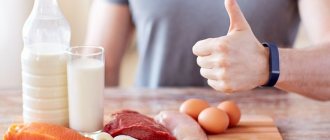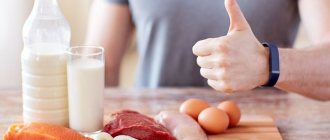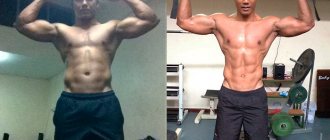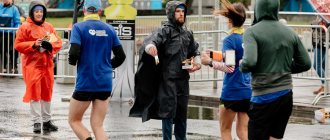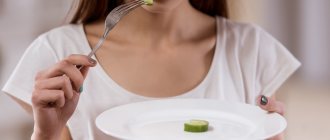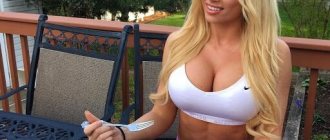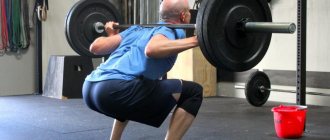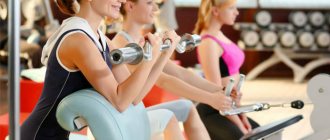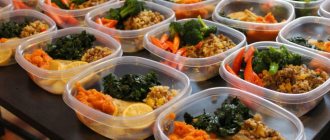A fitness diet is a godsend for girls who want to eat deliciously and at the same time lose weight. Its main advantage is its rich diet. No buckwheat or kefir days - the menu should be varied. An important condition: give up passive rest, replacing it with physical activity.
Work out in the gym or outdoors at least 3 times a week, dedicate 30 minutes a day to cardio training. Include foods rich in proteins and carbohydrates in your diet. These nutrients improve muscle function and provide the body with energy. It is better to minimize fat consumption - they slow down metabolism.
Principles of a fitness diet
- Smaller is better.
The portion should fit on your hand. - Take breaks
Eat at least 5 times a day. - Give up caffeine
After training, do not indulge in caffeine-containing products - coffee, chocolate. - Gain Energy
Eat well 2 hours before your workout. Excellent menu items: chicken fillet with rice, fish with salad, yogurt, oven-baked potatoes, vegetables. An hour before the start of classes, you can eat an apple, cottage cheese, a small portion of porridge or a pear. - Drink water
Drink still water 20 minutes before your workout and every half hour during it. - Love green tea
A cup of green tea rich in amino acids and glycogen will turn fat into energy, so you will burn more calories. Drink tea without sugar half an hour before starting physical activity. - Don't go hungry
Be sure to eat 20 minutes after your workout. At this time, the body absorbs proteins and carbohydrates well and turns them into muscle, not fat. Give preference to cheese, cottage cheese, egg whites, chicken, rice, fruits, vegetables, grape juice.
Before training
Before training, it is recommended to eat food rich in carbohydrates
.
In the understanding of the average person, carbohydrate food is something sweet. But foods containing too much sugar are a way of providing the body with energy, which ultimately lasts only for a very short time. A lot of glucose enters the blood, a large amount of insulin is released in response, and thanks to this, glucose is utilized almost immediately. Of course, at this moment a person feels a surge of strength and an improvement in mood. But by the time the workout begins, the energy boost ends and the strength disappears. And training a hungry person is not only ineffective, but also threatens health problems. Therefore, says Korochkin, before training it is better to eat complex or, as they are also called, slow carbohydrates that will be absorbed gradually: vegetables, whole grain products and cereals. Polished rice, pasta and white bread are not suitable for a pre-workout snack - these foods contain too much starch. And it is just as useless for providing the body with long-term energy as sweets. Be sure to drink enough fluids
before and during your workout . It improves thermoregulation and maintains metabolism at an optimal level. The ideal option is clean water. All sweetened drinks do not quench your thirst and, moreover, add extra calories.
Fitness diet menu for the week
Monday
Breakfast: orange, 2 egg whites, muesli with milk. Snack: peach and rice. Lunch: chicken breast, juice, durum wheat pasta. Afternoon snack: green apple, yogurt. Dinner: meat, salad.
Tuesday
Breakfast: milk, omelette, buckwheat. Snack: cottage cheese with banana. Lunch: juice, rice, salad, fish. Afternoon snack: oven-baked potatoes, a glass of low-fat yogurt. Dinner: vegetable and shrimp salad.
Wednesday
Breakfast: fruit, omelet, oatmeal. Snack: cottage cheese mixture with chopped banana. Lunch: rice with fish, salad. Afternoon snack: berries or fruits, yogurt. Dinner: white meat, vegetable salad, corn.
Thursday
Breakfast: oatmeal, omelette, fruit. Snack: rice, a glass of vegetable juice. Lunch: white meat, fruit. Afternoon snack: vegetable salad or cottage cheese. Dinner: light salad, chicken breast, piece of pita bread.
Friday
Breakfast: fruit, muesli with milk, 2 egg whites. Snack: 2 tablespoons of low-fat cottage cheese, a glass of carrot juice. Lunch: vegetable salad with chicken, baked potato, pear. Afternoon snack: a couple of fruits and yogurt. Dinner: boiled beans, fish and vegetable salad.
Saturday
Breakfast: a glass of milk, an orange, a portion of oatmeal porridge. Snack: small banana and cottage cheese. Lunch: rice with chicken fillet. Afternoon snack: a spoonful of bran and vegetable juice. Dinner: lean meat, boiled or canned corn.
Sunday
Breakfast: 2 egg whites, 2 tablespoons of low-fat cottage cheese, orange juice, a portion of oatmeal. Snack: Fruit salad topped with yogurt. Lunch: rice with vegetables and chicken. Afternoon snack: boiled or baked potatoes, a glass of yogurt. Dinner: salad, stewed fish, pear or apple.
Maybe
Nutrition and body weight changes
Managing an athlete's body weight can help optimize athletic performance and health (Tables 3 and 4). This program is the best means of monitoring health through the regulation of sports nutrition. Regulatory goals must be realistic and take into account many parameters: gender, type of sport, medical history, dynamics of changes in body weight and psyche. Body weight changes should be made during the off-season (15). Additional factors to consider when gaining or losing weight:
- Physical maturity of the athlete
- Increase in lean mass or decrease in fat mass
- Current weight and body composition
- Diet and habitual physical activity (eg, analysis of 3-day food and activity records) to determine energy intake and expenditure
- Frequency of monitoring the athlete's performance (weight/composition assessment at the beginning and every 1 - 2 weeks)
- It is useful to periodically evaluate the athlete's nutrition
- Improvements in body weight management should ideally occur primarily in changes in body composition rather than in weight.
Table 4. Food replacement table for reducing calories
| Instead of this | try it | Calorie difference |
| Cup of 2% milk (120) | Cup of skim milk (80) | 40 |
| Tuna in oil (170) | Tuna in its own juice (100) | 70 |
| Morning fast food sandwich (300) | English muffin (150) | 150 |
| Double hamburger (560) | Grilled chicken sandwich (400) | 160 |
| Caesar Salad (520) | Homemade salad (300) | 220 |
| Fast food fried chicken (400) | Grilled chicken breasts (170) | 230 |
| 6" Meatball (540) | 6" Turkey Cue Ball (280) | 260 |
| 475 ml coffee with caramel (430) | 475ml nonfat latte (160) | 270 |
| Taco Salad (790) | Cheese quesadilla (490) | 300 |
| Extra Large French Fries (610) | Small French fries (210) | 400 |
| Fast food shake (900) | Small Vanilla Cone (150) | 750 |
Interesting recipes
A variety of recipes for fitness nutrition follow the canons of a healthy diet and lifestyle. It is important to remember that the following should be excluded from the grocery basket:
- fast food;
- chips, crackers;
- industrial sauces;
- packaged juices, soda;
- processed cereals;
- first grade flour;
- sugar, sugar-containing products.
For busy people, we develop and prepare fitness meals for delivery to their home or work. And for those who like to know for sure what is in the plate, we offer several simple and interesting recipes.
Quick red fish
A favorite fitness food for many athletes, the recipes for preparing red fish are simple and always work out.
red fish
Recipe No. 1
Method of preparation: 1. Wash the broccoli, divide into inflorescences. Place on a baking sheet lined with foil or a baking dish. 2. Cut the salmon into medium pieces and place on top of the broccoli. This will help saturate the vegetable with salt and fish oil. 3. Place in an oven preheated to 180 degrees for 20 minutes.
Ingredients: • lightly salted salmon – 300 g; • broccoli – 200 g.
Salmon can be replaced with trout.
Milk buckwheat porridge on water
Often, fitness nutrition reveals long-forgotten recipes from a new perspective. You can vary the calorie content of milk porridge by changing the percentage of milk fat, as well as by diluting the product with water.
Milk buckwheat porridge
Recipe No. 2
Method of preparation: 1. Sort through the buckwheat, removing debris and black cores. Rinse with cold water. 2. Boil water in a saucepan with thick walls, add the washed buckwheat. Cook over medium heat for 10 minutes until the liquid is completely absorbed. Monitor the process so that the buckwheat does not burn. 3. Pour in the milk and continue cooking with the liquid simmering slightly. Cook until tender. If desired, add more milk. 4. At the end, add oil and salt.
Ingredients: • dry buckwheat – 100 g; • milk 2.% – 300 ml; • water – 200 ml; • butter – 10 g; • salt – 1 pinch.
Also, at the last stage, you can add a sweetener to the porridge to taste.
Selection of nutrients (BZHU)
The quality of the body depends on the proportions of proteins, fats and carbohydrates taken with food.
Squirrels
A building material in the human body, a source of amino acids. Participates in the restructuring of tissues of internal organs, hypertrophy of muscle fiber. The daily portion ranges from:
for women – 0.7 – 1.5 g per 1 kg of body weight for men – 0.7 – 1.7 g per 1 kg of body weight
The portion can be increased, but this is not necessary. The specified proportion is sufficient to complete the assigned tasks. There are no restrictions or prohibitions. It is important to monitor the reactions and condition of the body to change the amount of protein in the daily menu.
It is recommended to make a protein fitness meal for the week from the following products:
- meat, poultry;
- dairy products: cottage cheese, kefir, milk, yogurt;
- fish, seafood;
- eggs.
Fats
The addition of polyunsaturated fats (omega 3-6-9) helps the absorption of nutrients and maintains the condition of hair, nails, and skin. Also called healthy fats.
It is necessary to create a proper fitness diet that contains healthy fatty acids:
- red fish, seafood;
- unrefined oils – olive, corn, sunflower;
- avocado;
- nuts, seeds.
Carbohydrates
The energy source is represented by fast and slow connections. Fitness nutrition involves the consumption of complex carbohydrates, since it does not cause high spikes in insulin, helps in weight loss and maintains performance throughout the day. Record-breaking products for nutrient content:
- whole grain cereals, pasta;
- wholemeal bread;
- vegetables fruits;
- legumes
The direct dependence of BZHU is present in the question of the goals pursued - losing weight, maintaining weight or gaining weight.
How to choose a power mode
Fitness diet for men and women is different. For girls who usually engage primarily in cardio exercises and training to “tighten” their figure, sports nutritionists advise consuming more carbohydrates with a low glycemic index (about 50% of the total diet), and also not forgetting that fats, especially omega-3 fatty acids, - beneficial for the body. The average daily fat intake should be at least 20%, the remaining 30% protein.
Men who want to achieve muscle definition and muscle strength should pay more attention to the consumption of protein (up to 40% of the total daily intake) and carbohydrates - for weight loss it is worth reducing their consumption to 35-40%, for weight gain - increase to 55% . Fats during the “drying” period are limited to 20%, and during active muscle building the norm is 25%.
Principles of weight loss
- When energy expenditure exceeds energy intake (negative energy balance), a decrease in body weight occurs.
- Athletes looking to lose weight should target their intake to maintain muscle mass and reduce fat.
- Increasing energy expenditure and moderately reducing intake may protect against loss of strength and muscle mass during dieting.
- Weight loss should be gradual, approximately 250 – 900 g per week, which is equivalent to an energy deficit of 250 – 1000 kcal per day.
- Female athletes should not consume less than 1200 - 1400 kcal per day, male athletes should not consume less than 1500 - 1700 kcal per day. Athletes will not be able to maintain adequate micronutrient intake with such limited energy intake.
- Athletes need to drink enough when losing weight.
- You should not skip meals to prevent compensatory overeating.
- Aerobic exercise is preferred to create a negative energy balance, while resistance training will help prevent muscle loss.
Warnings
- Athletes, especially in sports with weight restrictions, may feel pressure to achieve low mass or unrealistic body composition. Such pressure leads to disordered eating and eating disorders.
- Negative energy balance leads to weight loss and endocrine disruption (11).
- These conditions present an extremely difficult situation for any professional guiding the weight loss process of athletes.
- Weight loss can impair performance by affecting energy reserves, weakening immune function, changes in behavior, enzyme activity, and structural changes in muscle.
- Rapid and excessive weight loss can have negative health effects, including cognitive dysfunction, cardiac dysfunction, and inability to maintain body temperature.
- To reduce the risk of injury, athletes should eat and drink properly before training and competition.
- Low-calorie diets and weight loss pills should be avoided.
- Recommendations for regulating body weight should be given by specialists with knowledge in the field of sports nutrition.
It is essential that the team physician knows the following:
- Changes in energy balance are key to weight management.
- Weight management can be achieved through dietary changes and exercise alone.
- Excessive or insufficient energy consumption can negatively affect health.
It is advisable for the team physician to do the following:
- Determined the necessary goals and methods for changing body weight.
- Consulted athletes regarding weight management products and fluids.
- Coordinated the efforts of staff involved in athlete weight management, including consultations and sports nutritionist work.
- Recognize warning signs of negative energy balance (eg, fatigue, decreased fitness, frequent illness and injury, eating disorders, and endocrine dysfunction).
- Was aware of the possible negative consequences of micronutrient deficiencies caused by negative energy balance.
- Dispelled myths associated with fad diets, low-calorie diets, and weight loss medications.
Nutrition during exercise
With prolonged exercise, the body's energy reserves are depleted, the feeling of thirst may become dull, and the rate of gastric emptying decreases. However, athletes need to consume fluids and nutrients for optimal performance. When the body's glycogen stores are depleted, muscles rely more on blood glucose for fuel, especially after 2-4 hours of continuous exercise. In addition, adequate fluid and electrolyte replacement is essential for normal cardiac function, thermoregulation, optimal performance and recovery, and helps prevent muscle cramps and electrolyte imbalances. An individualized plan is necessary to prevent overhydration, dehydration, and/or electrolyte imbalances.
- Fluid replacement should occur as early as possible during exercise and continuously during activity.
- For exercise lasting less than an hour, water or sports drinks are sufficient.
- Consumption of sports drinks is recommended when exercising for more than 1 hour.
- CHO in drinks is especially necessary when exercise is performed on an empty stomach after sleep or liver glycogen stores are low.
- Consuming 30–60 g of CHO per hour can increase the duration of long-term endurance exercise (3).
- Take 180 – 360 ml of sports drinks every 15 – 30 minutes. performing exercises increases the duration of effective performance of loads in athletes during continuous or interval work.
- Replenishing fluids with water alone can lead to hyponatremia. Athletes should avoid drinking too much water and drinking much more water than they lost during exercise. The drink should contain at least 100 mg sodium per 240 ml to prevent hyponatremia.
- Fluid and electrolyte losses vary depending on the sport, different people, and different environmental conditions. Athletes need to anticipate losses and adhere to recommendations regarding fluid intake.
- Potassium is essential for fluid and electrolyte balance. A diet rich in fresh fruits, nuts, seeds, dairy products, lean meats, and unprocessed grains is generally considered adequate to maintain normal potassium levels in athletes.
Warnings
- Athletes should not begin exercise when their energy reserves are depleted or when they are dehydrated.
- There is no need to consume protein or potassium when performing exercise to increase performance.
- CHO in solid form can also be consumed during exercise, but will be absorbed more slowly than liquid and gel forms. In certain sports (cycling racing) you can consume carbohydrates in solid form, while in swimming or running it is more convenient to use liquid forms.
- Hyperhydration fluids (eg, glycerol) do not improve performance or hydration and are not recommended for use.
